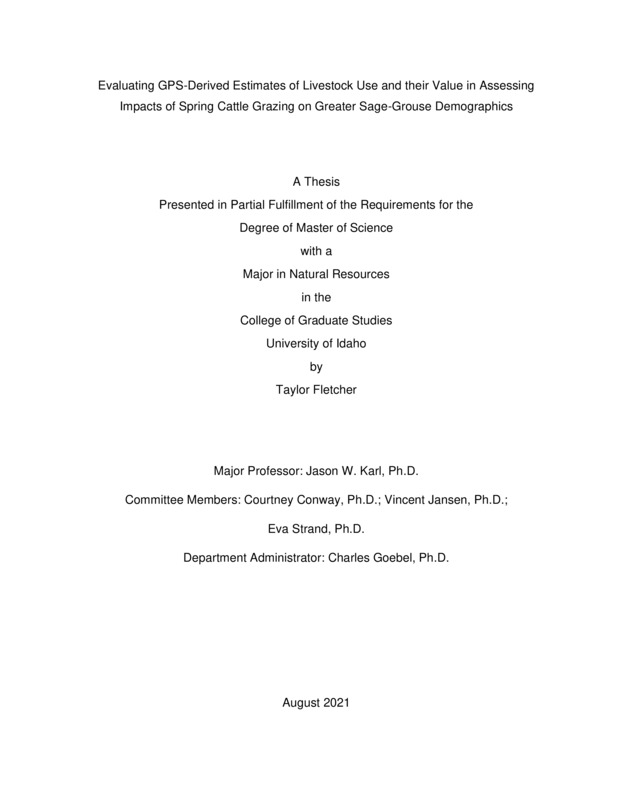Evaluating GPS-Derived Estimates of Livestock Use and their Value in Assessing Impacts of Spring Cattle Grazing on Greater Sage-Grouse Demographics
Fletcher, Taylor Lynn. (2021-08). Evaluating GPS-Derived Estimates of Livestock Use and their Value in Assessing Impacts of Spring Cattle Grazing on Greater Sage-Grouse Demographics. Theses and Dissertations Collection, University of Idaho Library Digital Collections. https://www.lib.uidaho.edu/digital/etd/items/fletcher_idaho_0089n_12143.html
- Title:
- Evaluating GPS-Derived Estimates of Livestock Use and their Value in Assessing Impacts of Spring Cattle Grazing on Greater Sage-Grouse Demographics
- Author:
- Fletcher, Taylor Lynn
- Date:
- 2021-08
- Program:
- Natural Resources
- Subject Category:
- Natural resource management; Range management; Wildlife conservation
- Abstract:
-
Domestic livestock grazing has been suggested as one of several factors contributing to the range-wide decline of the Greater Sage-Grouse (Centrocercus urophasianus; GRSG). However, inclusion of livestock grazing as one of the main causes of GRSG declines remains controversial because the short- and long-term effects of this land use on GRSG demographics are still not well understood. This is due to the fact that livestock utilization measures may be limited by observer bias and the plot-level scale at which data is often collected. Utilization measurements on a limited spatial and temporal scale may not lend well to informing large scale management decisions or assessing livestock-wildlife interactions. However, the advancement of Global Positioning Systems (GPS) has introduced new opportunities to efficiently and accurately collect livestock use and behavior data. I developed a metric of estimating the intensity of livestock use at pasture-scales based on location data obtained from low-cost GPS collars. I also evaluated how the estimates of livestock use and distribution changed with the number of GPS collars that were analyzed and the influence of extent and grain the livestock use and distribution metrics. I then used a bivariate version of the Ripley’s cross-K function to assess any co-occurrence or separation between the livestock GPS locations and confirmed GRSG nest locations. The results of the cross-K function produced differing results between the two study pastures. However, characterization of the vegetation structure around livestock hot spots and GRSG nests identified similarities between the portions of the landscape that each species used. This suggests that livestock and GRSG nests may occur in similar portions of the landscape. Thus improperly managed grazing may have negative consequences for GSRG populations. Further research is needed to determine if GRSG hens and livestock occur in similar areas irrespective of the presence of the other or if GRSG hens are preferentially selecting areas where livestock are actively grazing or have recently visited.
- Description:
- masters, M.S., Natural Resources -- University of Idaho - College of Graduate Studies, 2021-08
- Major Professor:
- Karl, Jason
- Committee:
- Conway, Courtney; Jansen, Vincent; Strand, Eva
- Defense Date:
- 2021-08
- Identifier:
- Fletcher_idaho_0089N_12143
- Type:
- Text
- Format Original:
- Format:
- application/pdf
- Rights:
- In Copyright - Educational Use Permitted. For more information, please contact University of Idaho Library Special Collections and Archives Department at libspec@uidaho.edu.
- Standardized Rights:
- http://rightsstatements.org/vocab/InC-EDU/1.0/

